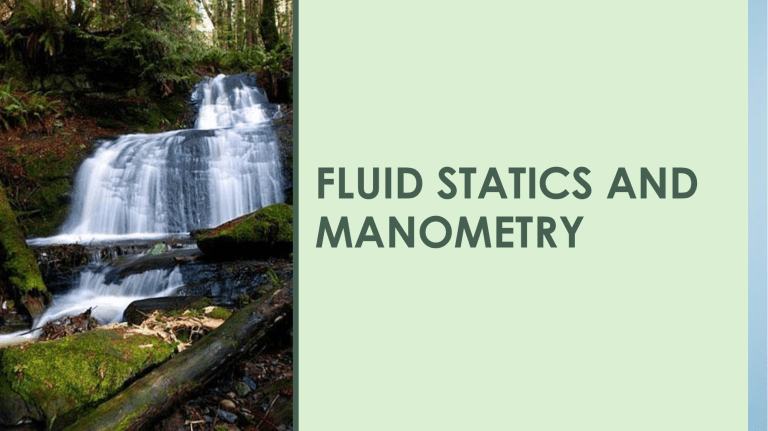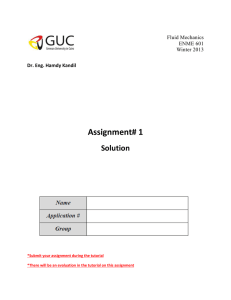
FLUID STATICS AND MANOMETRY Hydrostatics • Fluid statics (or Hydrostatics) is the branch of fluid mechanics which studies systems in which the fluid is at rest (i.e., fluid velocity is zero or is uniform and constant relative to an inertial reference frame. Note: Fluids at rest experience no shear stress. Pascal’s principle: The pressure in a fluid at rest is the same at all points with the same elevation. Basic Principle The basic property of a static fluid is pressure. Pressure is familiar as a surface force exerted by a fluid against the walls of its container. It also exists at every point within a volume of fluid. • Consider a differential volume of fluid at rest whose volume is dx dy dz • Consider the x-direction: P x dx P + P For fluid at rest: Fx 0 P dx dydz 0 Fx Pdydz P x P 0 x • The same goes for y-direction. Therefore, pressure does not vary in x- or y-direction. • Consider the z-direction: For fluid at rest: Fz 0 P dz dxdy gdxdydz 0 F P dxdy P z z This suggests that pressure varies in vertical direction. This is the equation that represents the hydrostatic principle (Pascal’s principle). The Hydrostatic Principle Assumptions: • There is no shear stress along z, i.e. static fluid. • Gravity is the only force acting on the fluid. • z-axis direction is defined vertical and upward • Since P does not vary along x- and y-direction: • Here, gc is the Newton’s law correction factor equal to 1 kg.m N-1 s-2 or 32.174 ft.lbm lbf-1 s-2. • For incompressible fluids (constant ), integrating the equation P g z gc • For compressible fluids at constant temperature, assuming ideal gas law applies, integrating the equation P g M ln 2 P1 gc RT z z 2 1 • If the temperature is not constant, the following equation in integral form applies: P g M z dz ln 2 P1 gc R 0 T(z) • In some part of our atmosphere, T varies with height. In troposphere (up to 11 km): T To z • where = - 0.00651 K m-1 (for air). • The variation of pressure with height is given by the following equation: P g M T z 2 ln 2 ln o P1 gc R To z1 • In stratosphere (about 11 to 32 km), T is constant at -550C. • Pressure Measurement Bourdon gauge normally used to measure gauge pressure in pipeline (on-line measurement) Barometer used to measure atmospheric pressure Manometer used to measure unknown pressure, or differences of two unknown pressures • Manometry • Manometry is a common and accurate method of measuring relatively low fluid pressure by causing the pressure to raise a column of liquid. U-tube Is an extension of the piezometer v.tiere a double limb tube · .....,, T' or "\.J" tube is used. A U-tube may be vertical, inverted, or indined. tube manometer The U measures difference between pressure and the the the absolute •• • atmospheric pressure. The difference is called the gage pressure and is frequently used in pressure measurement. The pressure w111•• .,,. . .. . , .,... 11, p 11111 A u-tube manometer of both liquids and gases can be measured using the same U-tube. A U-tube is connected as in Figure 5.2a and filled with a fluid called the manometric Duid. c D • h • -=.- G o s-_or- =:- - -• --- --li u id - - -- - ------== - --=- A= •• Va c u u m •• - - - (b ) (e ) .-····-··,,. 0 1!h e r D i f f e r e n t i e l· Perry's -------- .. .·-·-.... (c) ( F ig . C H E 11 0 - . . 0 U - 1. u b e u - ·t u b e m an om eter H a nd b o o k ); P e r r y 's c o n f i g u r a t io n s : C H E (b) U - tu b e H e n db o o k) ; p r e s s u r e d i f f e r e n c e m e a s u re m e n t b y m a n o m e te r 110 - 9 (Fig_ c lo s e d a (a ) (c ) U -t u b e • Consider simple U-tube manometer shown • Applying Pascal’s principle with A as the reference point: P P A B g h 0 gc 1 • Applying Pascal’s principle with D as the reference point: PD PC man g h2 0 gc density of gas is negligible compared with density of fluid in the manometer • Subtracting equation 2nd equation from the first and knowing that PC = PB and PD = Patm: PA PD g g h1 man h2 0 gc gc g PA Patm manh2 h1 gc Rules of thumb for multiple-tube manometers: • Any two points at the same elevation in a continuous volume of the same liquid are at the same pressure. • Pressure increases as one goes down a liquid column.


